Dear Alien aficionados, I am sure you miss the sense of dread, claustrophobia, and adrenaline-fueled survival mode you experienced while viewing the movie. Aliens: Dead Orbit by James Stokoe is a comic book that does just that. For Alien fans, Dead Orbit will be a welcome return to familiar territory.
For those who are 40 years late to the party or are just discovering the glories of the Alien universe, the Alien franchise revolves around a fairly simple concept: A tiny team discovers a very aggressive extraterrestrial, unlike anything we have ever encountered during a routine mission in the far future when humanity has grown into a space-faring race.
An increasing number of these aliens, known as Xenomorphs, are attempting to exterminate humanity, while a ragtag group of humans fights back with whatever means they have. Each film then follows a very standard formula.
With a few exceptions, Aliens: Dead Orbit follows the same general narrative. The major threat is posed by a pair of aliens, with unexpected twists such as survivors from another crew bringing fresh perspectives on old ideas. The manner in which Dead Orbit is told sets it apart from its predecessors. This is a story in the vein of the original Alien, with a small group of most vulnerable humans fighting for survival against a violent Xenomorph.
Come in, Over
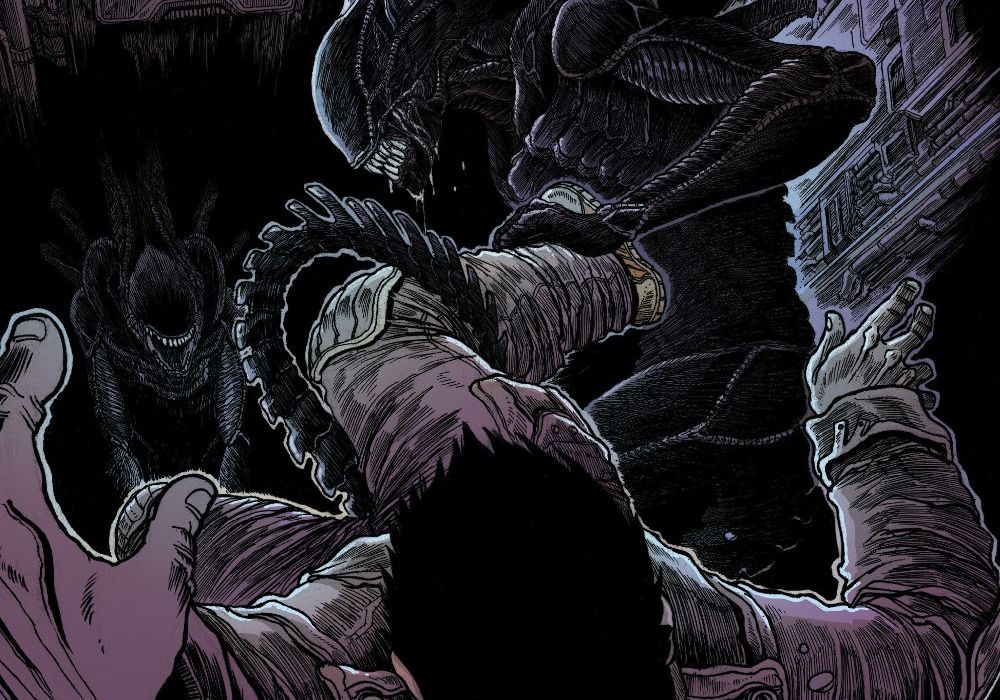
This first issue portrays the dread, alone, and unknown facet of the original film while also introducing you to a foul-mouthed action-oriented squad, similar to the space marines in Aliens.
The issue begins with a haggard, malnourished staffer named Wascylewski going about his duties aboard a remote Weyland-Yutani space station. As Stokoe recounts how Wascylewski came to be in this circumstance and the very real, very hungry opponent who is, ultimately, his only companion on the station, the ostensibly harmless setting progressively becomes a gloomy, claustrophobic nightmare. We see what happened on Sphacteria through flashbacks.
The flashback starts with the crew conversing with each other. The crew members are discussing a spaceship near them that the Captain is trying to get in contact with. It is natural and minimal in nature when the crew of the Sphacteria Station converses with one another.
They squabble and curse, occasionally revealing aspects of their existence but never assuming that something needs to be explained. There are no new characters or outsiders, and readers are left in a well-conceived and lived-in universe.
Throughout the panels, Stokoe shows us glimpses of what is to come, giving us an indication of the existence of the xenomorphs. They reach the ship and start to explore it. It is in a sorry state with metal falling off in places, but they find a functional life support system which indicates that there are people inside even though the ship is breaking down and is in shambles.
The crew members find three people inside the pods, two male and one female, frozen as if they were meant to be preserved. But the Captain, Hassan, decides to wake them up and tries to open the lids of the tank. The coolant tank ruptures when they try to open the lids. They crack open the covers as the three start going into shock due to heat burns. The crew brings the three back onto their ship.
Stokoe evokes sentiments of anxiety, confinement, and claustrophobia through his art. The atmosphere is a prominent theme throughout the issue; settings are gloomy, cold, and filled with shadows, creating a tense atmosphere. There’s a strong sense of loneliness in the air, especially as Wascylewski narrowly escapes a xenomorph and this issue comes to an end.
Look inside your heart
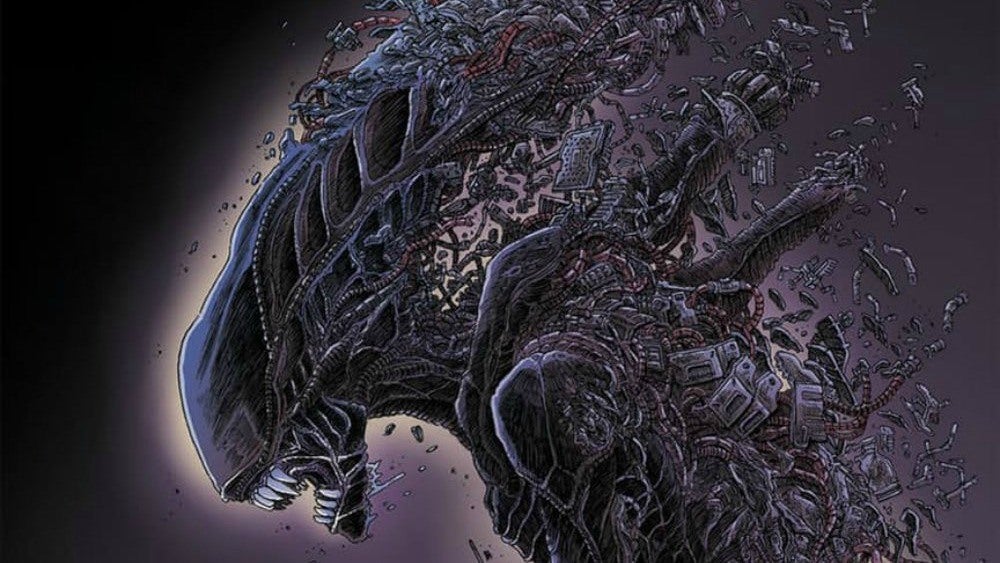
The first page of this issue opens with a guy speeding away from the ship’s hallways, which are pitch black. As he careens around another turn, Wascylewski throws a hand on the ground to keep his balance. Stokoe portrays the dash with frantic accuracy, with reddened cheeks that appear to be windburned and breath being spewed out with loud, violent grunts. There isn’t a moment of respite till Wascylewski arrives at the med bay and falls. He’s alone, but for a lifeless body wrapped in a crimson shroud and blood oozing to the ground in steady drops that appear to match the ticking of his watch.
Stokoe continues to tell two stories about one individual simultaneously, one in the past and one in the present, as he did in the first issue. We will begin with the latter and pick up just where we left off, with Wascylewski fleeing for his life, followed by the horrifying Xenomorph. The lone engineer hides in the ship’s medical facility after narrowly evading the Xenomorph, where he encounters a very dead, mangled, and leaky body peeking out from behind a sheet.
The sight of the dead body acts as a time machine, transporting us back into Wascylewski’s terrifying recollections to relive the events that led up to this point. Then we flash forward to the present day, where we are confronted with the dilemma of the missing and crucially essential case. Wascylewski’s watch is counting down to something technologically frightening that requires his immediate attention, and the notably absent case is maybe even more concerning.
When we get into the flashback, it also picks up just after the previous issue’s flashback. Wascylewski’s ship crew is now trying to help the ship crew they had discovered in their shattered cryo freezers. Things aren’t going so well right now. They appear to have returned them to their ship and sedated them.
The entire endeavor seems to have taken its toll on the doctor, who screams at the Captain and reiterates the terrible condition of the men. Their pain appears to be excruciating. Their skin has melted away, exposing nerves, muscle, and sinew. “Two of them don’t have any fucking lips, Captain!” says the ship’s doctor.
After things have cooled down a bit, the group sets out to figure out what they’re up against. The craft seemed to be used for cargo transport, as they took better notes about money than they did about almost everything else. They discover that there should be more staff with this information, but not much else before things start to go insane again.
As the cargo ship’s crew appears to be in great pain, they leave the medical area. They make a note of how much sedation they should be getting, but it’s not long until it reaches the point where two full-fledged chest bursters are making their way out of the med bay. Over the years, we’ve seen the chest-burster sequence a few times.
Perhaps the most gruesome and horrifying is the one depicted in this comic. It has to do with how Stokoe sets up the setting. The xenomorphs are a force to be reckoned with in this issue when they were a tiny element of the first. You almost forget that this is a foregone outcome as you wonder what is wrong with this individual.
Meanwhile, an unsettling “TH-THMP” sound can repeatedly be heard coming from his chest. You won’t be able to ignore it. It’s impossible to avoid. You are unable to close your eyes. Then it’s BAM! It’s a flurry of blood and agony. There is a new xenomorph on the loose.
With the chest bursters exiting the med bay, we return to the present, where Wascylewski is attempting to regain his composure before returning to retrieve the mechanism he had left behind. Once he’s on his way, the ship makes a Gravity-like spin as parts of the ship begin to fall off, causing a ship breach.
Wassy is in jeopardy before he can close the hatch leading to the open region since it is rapidly losing oxygen. The only drawback is that it appears that the system has failed, and he loses consciousness at the worst possible time, leaving us feeling concerned and scared for what is to come next!
Out of the fire, into the frying pan
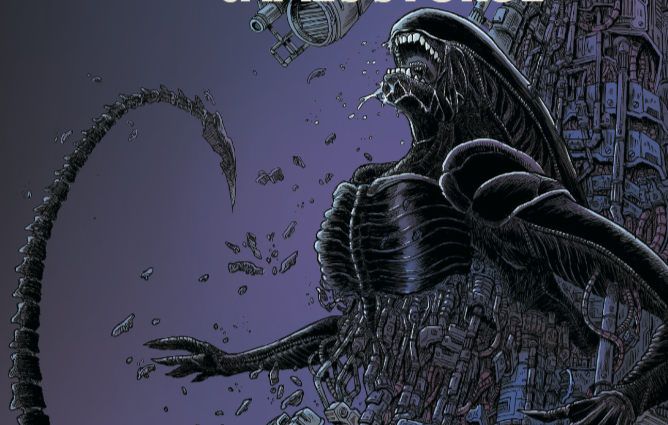
Wascylewski’s situation can be summarised as “out of the fire, into the frying pan.” After narrowly avoiding being swept into space’s icy, lifeless embrace, the chain-smoking engineer now faces a fate far worse than the one he almost survived.
The befuddled and terrified man awakens to find himself trapped inside a weird extra-terrestrial cocoon, unable to move. As if that wasn’t bad enough, one of his crewmates is also imprisoned, and the cocoon-like structure is practically swallowing him up. Worse, the two creatures who had murdered his crew and kidnapped him were sleeping just a few feet away.
As Wascylewski struggles to discover a way out, the ever-present countdown watch on his wrist triggers a flashback to when the crew was still alive and were beginning to realize the absurdity of their situation. From here, we’ll find out what happened to the last scavenging crew member and how the space station ended up in such a bad state of affairs.
We find out that Captain Hassan was one of the first ones to get captured by the Xenomorphs as the crew stood and watched. The other members of the team are reeling from the shock of his capture, Park and Torrenson bicker and disagree. Park wants to go back and look for Rook and Captain, while Torrenson just wants all of them to escape. Wascylewski takes the lead and makes all of them go back to the med bay to check on the doctor.
They find him being held by one of the people they had rescued. The woman is holding a knife to the doctor’s throat and asking about the twins. Their colony, it is revealed, was dead and infected. Their crew had frozen those three and left them inside as a warning. The woman sees the dead body of one of the chest bursters, slashes the doctor’s throat, and runs away. The crew is left reeling from the shock of another deceased.
But Stokoe doesn’t give us a moment to breathe even then. Wassy decides to run after her with the crew as she is also going to make a run for the shuttle. Unfortunately, she reaches inside before they can get to her. But her escape isn’t successful as she forgets to unhook the cord that holds the rescue shuttle to the main ship. Her shuttle crashes back into their ship instead, and we see Wassy back in the cocoon.
He gets up and escapes from the cocoons when he hears someone saying hello repeatedly. He finds a drunk Torrenson and asks him to keep quiet so the xenomorphs don’t hear him and then they can all escape from the ship. Stokoe ends the issue with the xenomorphs showing up right behind Torrenson, leaving us with no doubt that he won’t survive, but the dread you feel in the pit of your stomach doesn’t go.
How the fittest survive
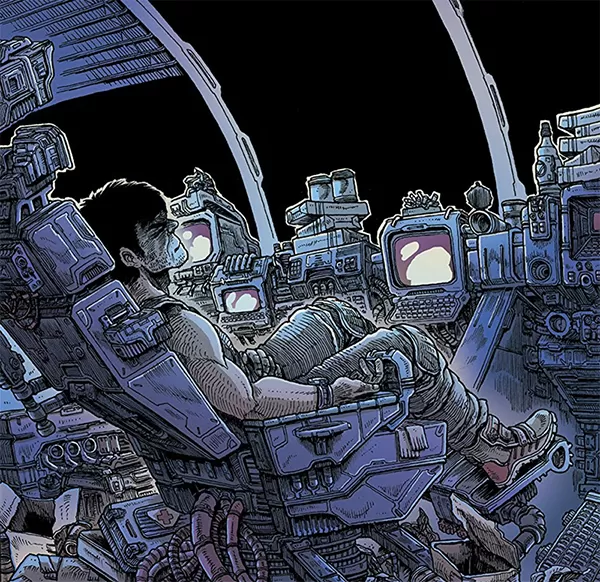
Stokoe shows off some considerable ingenuity with his narrative flow, fluidly shifting back and forth between flashbacks and the current day at a dizzying rate, to the point that the several timelines practically collide in the same panel on many occasions.
It’s a potentially unsettling approach, but Stokoe confidently takes it on, gently juxtaposing current occurrences with those that have previously occurred as he deftly presents the explanation of what happened to the rest of the Sphacteria crew and does so in a surprisingly visceral manner.
Stokoe uses minor adjustments in tone to assist differentiate between flashback scenes and those set in the current day, which helps keep things flowing smoothly throughout. Stokoe’s use of color to distinguish memories from the present is breathtaking. The cooler hues are used when Wassy is alone, as opposed to the red tones used while he’s with his team, which assist in bringing out a little more personality in the character we hardly get to meet.
After his failed attempts to rescue his crew’s lives, he appears to have less fear and more wrath in his eyes. You can see him move from hoping to survive to doing whatever it takes to ensure that no one else encounters these beasts. This issue successfully conveys the isolation of space while simultaneously conveying the frenetic pandemonium of the Captain and crew battling for their life.
Wascylewski’s narrative takes up precisely where we left him. Thanks to a drunken Torrenson’s hysterics enticing the xenomorphs to his location and away from Wassy, our favorite engineer narrowly missed becoming supper (as he calls Wascylewski). As we can see, the twin xenomorphs have had enough of playing cat and mouse and have dispatched the intoxicated and delirious security officer.
The Xenomorphs have never been more terrifying. Unlike in a film, where they could be obscured by shortcuts and shadows, they’re on the whole show here, letting you see every last aspect of these incredible and scary creatures. Even with some minimal lines, Stokoe adds strokes of information.
Although the aliens are unstoppable killing machines, Wascylewski is a cunning man. He’s flying by the seat of his trousers and comes up with a plan to escape while still stopping the Xenomorphs. With its ever-increasing degree of intensity, it’s like something straight out of an action movie. Wascylewski is now the final surviving crew member of the space station Sphacteria following Torrenson’s death.
We see the end of crew member Park’s journey and the events that led to the situations we encountered at the start of this story through a series of wonderfully interwoven flashbacks. When it comes to the beginning, there’s a small metal box that’s been around from the first few pages and has nearly killed Wassy countless times.
The preoccupation with the box and the extent to which people go to preserve it isn’t without reason, as we soon realize it’s our desperate survivor’s only hope. Wassy intends to use explosives to detach a portion of the space station from the main body and float away in it like a lifeboat. It’s essentially his only chance, given the lack of other weapons on board.
Before an Alien bursts from a ventilation shaft above him and attacks him, Wascylewski succumbs to weakness and takes them with him. As he prepares to depart, he finds a bag in the locker containing a spare box of cigarettes. Wassy, in a fit of rage, tugs on the bag, bringing the entire locker crashing down on the Xenomorph.
This gives him enough time to detonate a charger and blow a hole in the ship’s wall, allowing him to enter space’s atmosphere. Wassy’s compression suit permits him to stay on the station’s surface, but the Alien pursues him. Wassy detonates another charge as the thing approaches, disconnecting the life support module from the station.
This shows us one of the most stunning visuals of the series, as Wascylewski has just blown a hole in the space station and is on his way to space. A shattered pipe billows smoke as the last Xenomorph emerges from the ruins. In the half-page photo, it’s kneeling there, injured but lethal as ever. Its arm is missing half of its length, and its side is scarred horribly. Its acid blood is evaporating into the ether in droplets.
Wassy notices this and enters a room with multiple oxygen tanks. Wassy raises one in front of the approaching Alien, and the creature’s acid blood, floating through space, collides with the tank, blasting Wassy and the Alien into space.
Wassy sighs a sigh of relief and pulls out his pack of smokes inside the module, which is now drifting aimlessly in empty space. An adjacent terminal abruptly warns that oxygen levels are critically low and starts a countdown, which begins at 04:02:56. Wassy smokes his last pack alone as the timer ticks away.
Why should you read Alien: Dead Orbit?
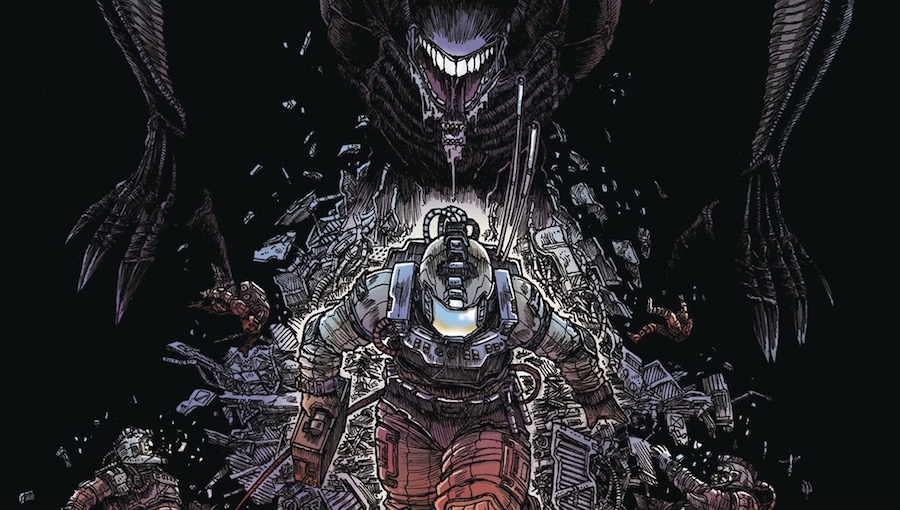
The number one reason to read dead orbit is, well, aliens. It is a brilliant story that perfectly captures dread, anxiety, and claustrophobia one might experience in an adrenaline-riddled survival situation too in comic form. It takes one right back to the feeling of watching Alien for the first time.
The general tone and plot of ‘Dead Orbit’ resemble a lot of what we saw in the original Alien, yet it in no way detracts from the book’s quality and execution. One of the best settings for this genre is a gigantic structure in space, with only a few humans and death lurking in the darkest shadows, and this story, like the first film and the 2016 video game Alien: Isolation, uses it not as a crutch, but as a real storytelling strength. It works better in this universe than a lot of other entries from various mediums.
When it comes to employing silence as a storytelling tool, Stokoe is one of the greatest in the business. He swiftly and deftly sets the tone for this story, gradually increasing the tension on every page until the climactic final few issues. Alien comics rarely match the original film in terms of scare level, but Stokoe doesn’t have that problem.
Stokoe also creates a unique and compelling picture of the Alien universe. Dead Orbit does a better job than any other Dark Horse comic at capturing the gritty, industrial atmosphere of the movie. The level of detail that Stokoe puts into each page is incredible. His spacecraft and tech designs appear to be a jumble of thousands of smaller parts.
Stokoe’s art is notable for its innovative framing choices and ability to generate such a real sense of dread, in addition to the exquisite line work. Stokoe even lettered this issue himself, allowing him to include various sound effects and computer displays directly into his artwork and maximize the impact of sound (when it does appear). While looking at some of the variant covers, it became clear that the ships and their designs were intended to resemble the Xenomorphs’ texture and skin. It is a lovely little touch, and it adds so much more to the concept.
Aliens: Dead Orbit accomplished precisely what it set out to do. It developed a dark, depressing scenario about being imprisoned in space with an unforgivable creature that feels more like the first Alien film than any of the sequels. The tale is terrible, the graphics are unsettling, and you have a pit in your stomach after seeing it. It’s everything an Alien film should be. It is a must-read for fans of the film, alien comic, great graphics, and brilliant storytelling.
